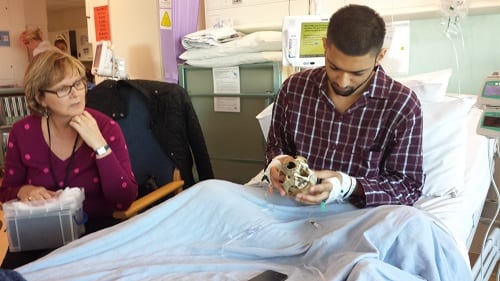Please can I see the Fossil Lady?
By Celine West, on 19 August 2015
This is a guest blog written by Alison South, volunteer for UCL Museums.
The dayroom on Ward 12 at UCH (University College Hospital) is bright and spacious with views west along the busy Euston Road. Here patients at the Teenage Cancer Trust Unit relax with their families and friends, putting aside illness, treatments, sickness and drugs for a while, chatting or enjoying a game or other activity. Over the last year I’ve become a regular visitor, bringing with me a bag of museum objects from the Touching Heritage handling collection at UCL Museums.
I vary my choice of 8-10 objects each week, but always include some fossils and rocks from the Geology collections, natural history specimens and Ancient Egyptian artefacts. Some on the ward refer to me as the ‘fossil lady’ or the ‘museum lady’ – I prefer to think of myself as a sort of therapeutic ‘bag lady’ holding tight my precious possessions.
Many of the objects were originally selected for this project because of their connection to health and wellbeing and each one comes individually packed with a card bearing a short description, photograph and one or two interesting facts. Did you know, for example, that the name ‘amethyst’ comes from the Greek word ‘amethustos’ meaning ‘without drunkenness’ because the Ancient Greeks believed that this stone gave protection from poisoning and cultivated a sober mind?
Often the sessions start with a sense of wariness: I feel people asking themselves “is seeing objects from a museum a fun activity? Was it really a good idea to agree to join this session?” By holding the objects one at a time in their hands, exploring them through touch as well as sight, people enter into a different relationship with them. Quickly and easily a true sense of excitement grows at handling something ancient, extraordinary, strange and beautiful, whether it is recognisable or mysterious. There are no set rules on how to explore and enjoy these objects and my role is that of a facilitator, not of a teacher. Each object speaks for itself and conversations develop both instinctively and with the help of the notes on the accompanying card.
Patients ask many questions and phones are at the ready to take photographs, look things up online and illuminate interiors with a torch. Parents, family and friends join in, enjoying the opportunity to talk about something completely different and beyond their shared in-patient experience. Often the objects bring back memories, such as visits to other museums, recollections of seeing dinosaurs and fossils in childhood, and we share these precious stories. For one person, pieces of ceramic pottery from Ancient Iraq brought back memories of water pots and wells in rural Nigeria.
Some of the favourite objects we handle are
- Smoky quartz used in ancient China to make sunglasses, also the national gem of Scotland
- Fossilised tooth from a Megalodon shark, one of 276 it would have had
- Ancient Egyptian stone cosmetic pot, beautifully carved, smoothed and rounded, a joy to hold
- Ancient Egyptian Bastet goddess figurine clutching a basket in one hand, a rattle in the other
- Puma skull and jaw, people tend to love or hate this one
- Roman roof tile with paw prints, walked on whilst drying in the sun
- Micraster burrowing sea-uchin fossils, my personal favourite, known in the past as ‘fairy loaves’, used as charms in bread making and kept on window sills in Sussex to ward off lightning strikes
I’m now very familiar with the objects in this handling collection and the facts which surround them, but each week I’m challenged to view them in a new way. “What is it worth?” is a frequent question, which introduces wider issues about museums and how they value objects.
There’s also the opportunity to invite patients and families to explore UCL Museums either online or by visiting them when they are able to do so. In the meantime, interesting objects will continue to appear each week on Ward 12 ready to be explored by any and all curious and inquiring minds.
Alison South is a volunteer for UCL Museums.
Object handling at UCH is part of a long-standing programme of work at UCL Museums in the area of touch and wellbeing. Groundbreaking research into how handling obejcts affects health and wellbeing has involved a wide range of public and heritage institution partners, leading to publications and a wellbeing measures toolkit. Our latest work in this field is Museums on Prescription, which will connect people referred through Social Care and the NHS with museums http://www.ucl.ac.uk/museums/research/museumsonprescription
UCL Public & Cultural Engagement also leads the new National Alliance for Museums, Health & Wellbeing, a place where information and resources in this area are shared: https://museumsandwellbeingalliance.wordpress.com
Celine West is Head of Learning & Access for UCL Public & Cultural Engagement
 Close
Close



